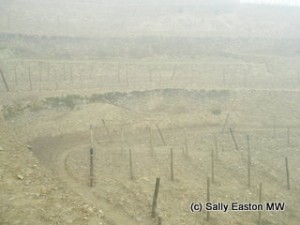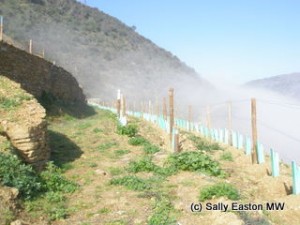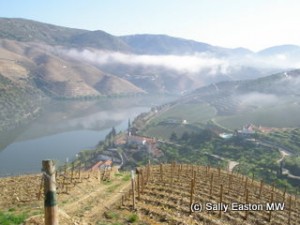Quinta de Vargellas vineyard regeneration

Tractor path visible
An almost-breathtaking regeneration project has been undertaken at Quinta de Vargellas in the Upper Douro, the flagship estate of Taylor’s Port, part the Fladgate partnership who are one of the key producers of Port wine.
Their viticulturist, António.Magalhães, explained. In general, he said, “we replant 2-3% of our vineyard each year, which means we don’t change the average age of the vineyard.” As part of this, in the mid 1990s Vargellas embarked on a five-year project to rebuild a section of some of the company’s oldest hillside vineyards – in a project they called their ‘new old-vineyard model’.
The original Douro vineyards were usually singles rows of vines on a terrace with a flat soil surface, and vertical walls. This has always been the best terracing system against the perpetual event of ready erosion.
Often when old vineyards were replanted the vertical wall terracing was replaced with an alternative system that can allow at least some mechanisation. However, none of the ensuing terracing systems, which were developed to allow varying degrees of mechanisation, has effectively dealt with the erosion issue.
Seven years ago, said Magalhães “we came up with a solution – a new old vineyard”, which retains the vertical stone walls and flat vineyard surface that are best practice, and allows some mechanisation.

Replanting
Other factors are addressed with the new old vineyard model. Given the convoluted dance the river makes around the schistous slopes, although all the vineyards are on the left, or southern bank, of the river Douro, meaning most vineyards face north, some face south, and others everything in between. This fixed feature of mountain vineyards has resulted in fine-tuned planting regimes, as has also been necessitated by the range of altitude in Vargellas’ 76 hectares, from 120 to 320m above sea level.
This new vineyard model is also in keeping with the heritage and preservation requirements of the Alto Douro’s UNESCO world heritage status, a standing its held since 2001.
Vargellas has replanted its steep, 3.5ha Vinha Grande vineyard according to the new model, where the terraces are reconstructed using precision laser-guided control. Then, at the bottom of each vertical stone terrace, right next to the wall, is enough space for a small caterpillar tractor to run. This ‘simple’ adjustment allows some vineyard operations during the year, such as canopy work, to be at least partially mechanised.
“The second difference” said Magalhães “is the density. We have the same density of vines per hectare, but we plant 80cm between each vine and 1.4m between the rows, so we get 5 to 6,000 vines per hectare.”
The third difference “are the micro-blocks of single grape varieties” Magalhães said, to take account of variety preferences, such as tinta roriz preferring windy, less fertile soils, so it is planted on vineyard spurs. Or tinta cão on more exposed parcels because “the skins are resistant to sunburn and tinto cao is late ripening”, he added.

View from top of Vinha Grande
The aim of these fastidiously detailed micro-blocks, said Magalhães “is to ripen the different varieties at the same time” which will ease the winemaking process, allowing each grape variety to be treated during the year according to its particular needs, and to be harvested together.
The cost of the project has been considerable. Magalhães said “to repair a terrace wall costs €30 to 40 per square metre with our own workers.” But before the rebuild started five years ago, half the vines in this parcel had died, so something dramatic needed to happen.
The vineyard may be a modest 3.5 hectares, but Magalhães said the team had rebuilt 650 metres of wall each year – more than three kilometres over the five years.
My research visit to the Douro was sponsored by the ‘Discover the Origin’ campaign.



